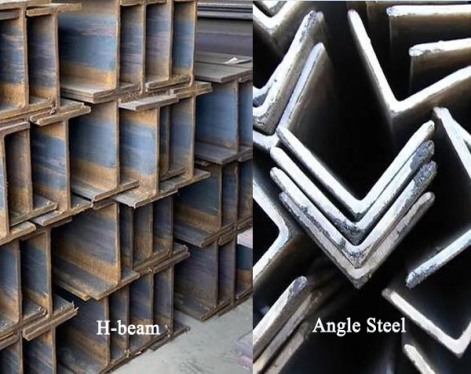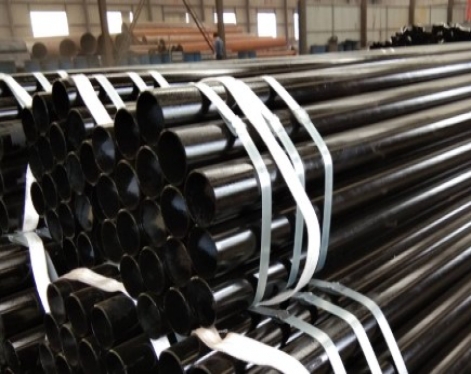Angle steel is a common metal material. Due to its strong bearing capacity, corrosion resistance and stable quality, it is widely used in construction, machinery, ships, railways, roads and bridges. In today's society, angle steel has become an indispensable industrial material. There are significant differences in the process between angle steel and H-beam steel, which are mainly reflected in the production method, processing process and application characteristics.
1. Production method
Angle steel: There are two main production methods for angle steel: hot rolling and cold drawing. Hot-rolled angle steel is to heat the steel billet to a certain temperature, roll it on a roller, and press it into a steel of a specified shape. This production method can ensure that the surface quality of the angle steel is good, the size is accurate, and the quality is stable. Cold drawing is to first cool the heated steel billet to room temperature, and then roll it into strands through continuous cold drawing. Compared with hot rolling, this method of production has the advantages of fast forming and simple process, but it is more likely to produce surface cracks and is not suitable for producing angle steel that withstands strong forces.

H-beam: The production process of H-beam mainly includes the steps of smelting, rolling, finishing and inspection. First, the molten steel is smelted in an electric furnace or converter, and the impurities and gases are removed by refining. Then, the molten steel is poured into the rolling mill for rolling to form the initial shape of the H-beam. Next, the rolled steel is subjected to finishing treatments such as straightening, trimming and cutting to obtain qualified H-beam. Finally, the finished steel is inspected for quality to ensure that the size, shape and surface quality meet the standards.
2. Processing technology
Angle steel: The processing technology of angle steel generally undergoes shearing, cutting, punching, drilling, welding and other processes. Among them, the most basic processing technology is shearing. Shearing is the process of processing long strip angle steel into corresponding lengths. For smaller angle steels, cutting and other processes can be used. The processing process is simple and the processing accuracy is easier to control. For larger angle steels, punching, drilling and other processes are required to meet the requirements of different projects.
H-beam: The processing of H-beam is relatively complex, mainly involving its unique cross-sectional shape and performance requirements. During the rolling process, parameters such as rolling temperature, rolling force and rolling speed need to be strictly controlled to ensure that the cross-sectional shape and performance of the H-beam meet the design requirements. In addition, the cutting, welding and other processing processes of H-beam also need to be adjusted and optimized according to its special cross-sectional shape.
3. Application characteristics
Angle steel: Angle steel is widely used in construction, machinery, ships, railways, roads and bridges due to its strong bearing capacity, corrosion resistance and stable quality. It is usually used as a structural member or connector and can withstand large forces and moments.
H-beam steel: H-shaped steel is widely used in large-scale buildings, bridges, tunnels, ports and other engineering fields due to its high bending strength, good structural stability and uniform material. The cross-sectional shape of H-shaped steel enables it to give full play to the strength characteristics of the material and improve the bearing capacity and stability of the structure. At the same time, H-shaped steel has a high degree of standardization, is easy to process and install, and can greatly shorten the construction period and reduce engineering costs.
In modern engineering construction, angle steel has become an indispensable basic material for the construction industry and machinery industry. Its comprehensive use cost is low, its practicality is strong, and its life is long, which is difficult to replace by other materials. In order to make better use of angle steel, a valuable resource, and promote the development of the angle steel industry, we can take the following aspects as development directions:
1. Improve processing quality. The processing and manufacturing industry is an important production field of angle steel. It is necessary to enhance the awareness of technological innovation, improve the processing quality and precision of angle steel, and ensure the service life and performance of angle steel. It is necessary to match the processing technology with the product characteristics of angle steel to improve industrial competitiveness.
2. Increase product research and development efforts. Scientific and technological innovation is the central link in promoting the improvement and reform of processing technology, and it is necessary to increase the research and development of angle steel products. Strengthen relevant technical research, formulate and implement technical standards, expand the application field, meet people's constantly upgraded needs, and promote the sustainable development of the angle steel industry.
In short, angle steel is a stable and durable metal material with broad application prospects. Strengthening the quality supervision, publicity and promotion, and innovative research and development of angle steel will be conducive to promoting the further growth and development of the angle steel industry. We need to continuously improve our skills to adapt to the high-demand development in the future.
1. Production method
Angle steel: There are two main production methods for angle steel: hot rolling and cold drawing. Hot-rolled angle steel is to heat the steel billet to a certain temperature, roll it on a roller, and press it into a steel of a specified shape. This production method can ensure that the surface quality of the angle steel is good, the size is accurate, and the quality is stable. Cold drawing is to first cool the heated steel billet to room temperature, and then roll it into strands through continuous cold drawing. Compared with hot rolling, this method of production has the advantages of fast forming and simple process, but it is more likely to produce surface cracks and is not suitable for producing angle steel that withstands strong forces.

H-beam: The production process of H-beam mainly includes the steps of smelting, rolling, finishing and inspection. First, the molten steel is smelted in an electric furnace or converter, and the impurities and gases are removed by refining. Then, the molten steel is poured into the rolling mill for rolling to form the initial shape of the H-beam. Next, the rolled steel is subjected to finishing treatments such as straightening, trimming and cutting to obtain qualified H-beam. Finally, the finished steel is inspected for quality to ensure that the size, shape and surface quality meet the standards.
2. Processing technology
Angle steel: The processing technology of angle steel generally undergoes shearing, cutting, punching, drilling, welding and other processes. Among them, the most basic processing technology is shearing. Shearing is the process of processing long strip angle steel into corresponding lengths. For smaller angle steels, cutting and other processes can be used. The processing process is simple and the processing accuracy is easier to control. For larger angle steels, punching, drilling and other processes are required to meet the requirements of different projects.
H-beam: The processing of H-beam is relatively complex, mainly involving its unique cross-sectional shape and performance requirements. During the rolling process, parameters such as rolling temperature, rolling force and rolling speed need to be strictly controlled to ensure that the cross-sectional shape and performance of the H-beam meet the design requirements. In addition, the cutting, welding and other processing processes of H-beam also need to be adjusted and optimized according to its special cross-sectional shape.
3. Application characteristics
Angle steel: Angle steel is widely used in construction, machinery, ships, railways, roads and bridges due to its strong bearing capacity, corrosion resistance and stable quality. It is usually used as a structural member or connector and can withstand large forces and moments.
H-beam steel: H-shaped steel is widely used in large-scale buildings, bridges, tunnels, ports and other engineering fields due to its high bending strength, good structural stability and uniform material. The cross-sectional shape of H-shaped steel enables it to give full play to the strength characteristics of the material and improve the bearing capacity and stability of the structure. At the same time, H-shaped steel has a high degree of standardization, is easy to process and install, and can greatly shorten the construction period and reduce engineering costs.
In modern engineering construction, angle steel has become an indispensable basic material for the construction industry and machinery industry. Its comprehensive use cost is low, its practicality is strong, and its life is long, which is difficult to replace by other materials. In order to make better use of angle steel, a valuable resource, and promote the development of the angle steel industry, we can take the following aspects as development directions:
1. Improve processing quality. The processing and manufacturing industry is an important production field of angle steel. It is necessary to enhance the awareness of technological innovation, improve the processing quality and precision of angle steel, and ensure the service life and performance of angle steel. It is necessary to match the processing technology with the product characteristics of angle steel to improve industrial competitiveness.
2. Increase product research and development efforts. Scientific and technological innovation is the central link in promoting the improvement and reform of processing technology, and it is necessary to increase the research and development of angle steel products. Strengthen relevant technical research, formulate and implement technical standards, expand the application field, meet people's constantly upgraded needs, and promote the sustainable development of the angle steel industry.
In short, angle steel is a stable and durable metal material with broad application prospects. Strengthening the quality supervision, publicity and promotion, and innovative research and development of angle steel will be conducive to promoting the further growth and development of the angle steel industry. We need to continuously improve our skills to adapt to the high-demand development in the future.









